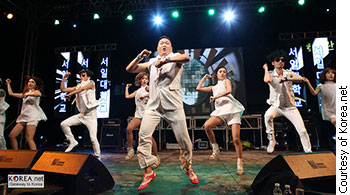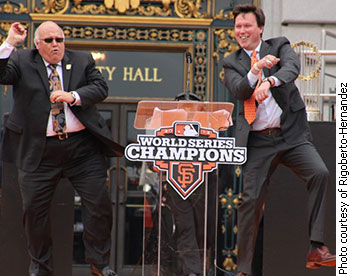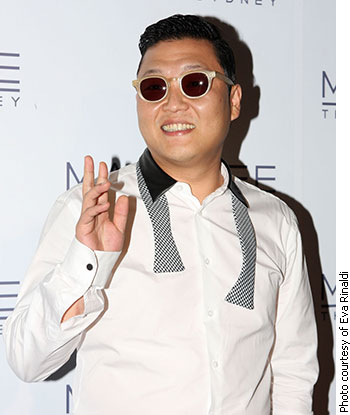Tags
Related Posts
Share This
Viral madness: How ‘Gangnam Style’ changed the world
Step with your right leg; step with your left. Back to the right leg; right one more time. Hands out in front; then one fist clenched over your head, elbow slightly bent, making a circular motion. But chances are you already know this dance move because, like more than a billion others around the world, you’ve seen it. Yes, we’re talking about “Gangnam Style”: the most popular YouTube video ever.

Psy and friends perform “Gangnam Style” at Seoil College in Seoul.
“Gangnam Style” is a song by South Korean artist Psy. It is also one of the most powerful dance phenomena we have ever seen. It has taken over bars, clubs, sporting events and even political debates, all because of one viral video.
“Gangnam Style” was released on July 15, 2012, and received about 500,000 views on its first day. It reached one million views at the beginning of August, and by the week of August 28 it was number one on YouTube Top 100 Music Videos.
On December 21, 2012, it became the first online video to be viewed one billion times. As of mid April 2013, it had had 1.523 billion views.
‘I think it’s one of those things like car accidents; you can’t help but look.’ — Viral video expert Kevin Nalty
This all despite the widely held opinion that, as a matter of fact, the music isn’t very good. “I think that it wasn’t so much the song itself, but sort of the whole mojo of the video,” says viral video expert and YouTube comedian Kevin Nalty, admitting he doesn’t like the song. “I think it’s one of those things like car accidents; you can’t help but look.”
They all do Gangnam
The scene is Alumni Stadium, home to the Boston College Eagles football team. The Eagles are losing to the Notre Dame Fighting Irish on a beautiful New England fall 2012 Saturday night.
It is in the second quarter, after the BC marching band’s rendition of “Call Me Maybe,” that the familiar sights and sounds of Psy’s “Gangnam Style” hit the 44,500-seat stadium’s big screen. The band plays along; the fans belt the words. Most importantly, they all do the dance. They always do the dance. The cheerleaders do it; the fans do it; even the mascot does it. It is the only music video that plays on the big screen all night. And just about everyone in the stadium has seen it, as a couple of now-famous dance moves prove.
This is what happens when Internet culture seeps into real life. “I think what happens with something like this […] at some point it’s almost like a commodity you trade with,” says Nalty. “‘Did you see that?’ is basically code for ‘I’m in early; I’ve already seen it; I’m hip to it.’ It’s sort of a badge of honour.”

San Francisco Giants radio announcers Jon Miller (left) and Dave Flemming celebrate the team’s World Series win, Gangnam style.
But what is really incredible about “Gangnam Style” is how it has reached older generations — ones that didn’t grow up with the Internet, ones that are known often for criticizing their children’s music. These generations are not only embracing “Gangnam Style”; they are celebrating it.
On several instances, well-respected, world-renowned people have proven they can’t get enough Gangnam. United Nations Secretary General Ban Ki-moon danced “Gangnam Style” alongside Psy during a photo op at UN headquarters. London mayor Boris Johnson, at a Conservative party conference in October 2012, told delegates, “‘Gangnam Style’ is very good. The Prime Minister and I danced ‘Gangnam Style’ the other day, you will be shocked to discover.”
President of the International Criminal Court, Song Sang-Hyun, mentioned it during a speech to the UN Security Council. U.S. President Barack Obama mentioned it, saying to WZID FM in New Hampshire, “I just saw that video for the first time… I think I can do that move.” Never has an Internet fad spread so quickly and so powerfully, and through such impressive ranks.
Here to stay?
So how do we explain such an explosive transformation, from Internet sensation to pop icon? Psy has something to do with it. “There’s just something about this guy that’s so opposite your common pop singer,” says Nalty. “Overweight, goofy, but clearly confident in himself.”

All the right moves. South Korean pop artist Psy’s “Gangnam Style” is the most viewed YouTube video of all time.
“The common ingredients are there,” Nalty continued. “It’s interesting; it hasn’t been done before; it’s catchy; it’s new. Dancing and music are always good ingredients in a viral video.”
Wall Street Journal Korean Correspondent Evan Ramstad says the video’s madcap attitude is atypical of Korean pop videos. “The dance adds to it, because it is both funny and easy to imitate,” says Ramstad. “The bass-rhythm groove is also memorable and unmistakable when you hear it.”
“Gangnam Style” is the most powerful example of how viral video can impact our culture. But it is just one of many. “It’s sort of like a fabric of society,” Nalty says of viral video. “We all sort of consume it, and nobody’s left out.”
“Gangnam Style” and other viral videos like it create a societal bond because of their ability to reach such a mass audience. But Gangnam’s eccentricity and downright silliness is what sets it apart.
Says Nalty, “After a while it just becomes a cliché. I think once it gets to a point where everybody’s universally familiar with, it begs to be satire. I think we’re all looking for something a little offbeat.”
What is viral?
The term “viral” is tossed around often. But what is a viral video? According to Viral Actions: Predicting Video View Counts Using Synchronous Sharing Behaviors, a study done by David A. Shamma et al., “Viral videos are those that have gained outsized prominence and viewership as a result of an ‘epidemic-like’ social transmission.” Shamma elaborates on this in a phone interview: “There is an ideal hope that viral video can exhibit this pattern of contagion.”
But how do we quantify contagion and epidemic? “I used to say if a video has between 3 and 5 million views in a short period it was viral,” says Nalty. “Increasingly, however, the bar has been raised. Now something could be considered viral if it’s being discussed offline, on other social-media networks and in the media.”
A brief history of viral dance
Don’t be mistaken; we’ve seen this before, sort of. Recall the Macarena dance craze in the mid-nineties: Foreign artist makes song, creates catchy dance move, films music video, and it blows up. But the Macarena could have never had the same impact as “Gangnam Style”. The difference is, that was then, and this is now. Released in 1993, the song “Macarena” lacked the amazing impetus of the Internet. The “Gangnam Style” video, released in July 2012, was viewed 500,000 times on its first day.
The only song-dance video to rival “Gangnam Style” in virality was “Crank Dat”, with its Soulja Boy dance, invented by the rapper of the same name. “Crank Dat” was 2007–08’s “Gangnam Style”, gaining worldwide fame thanks largely to its dance moves (garnished with a back and forth motorcycle crank-the-accelerator gesture). The popularity of “Crank Dat” transcended music. It became a social phenomenon and a political symbol — much as “Gangnam Style” did in 2012.





